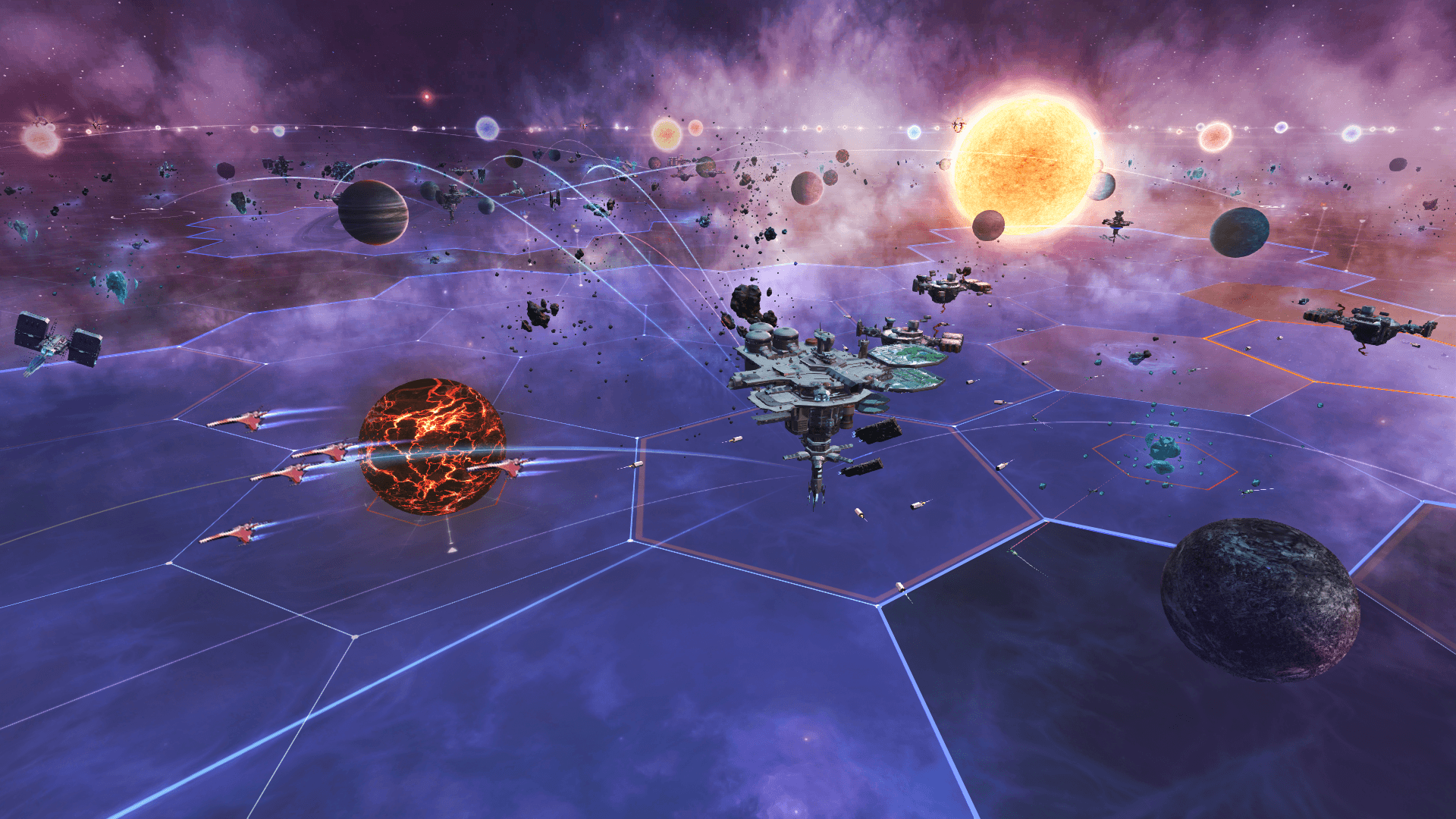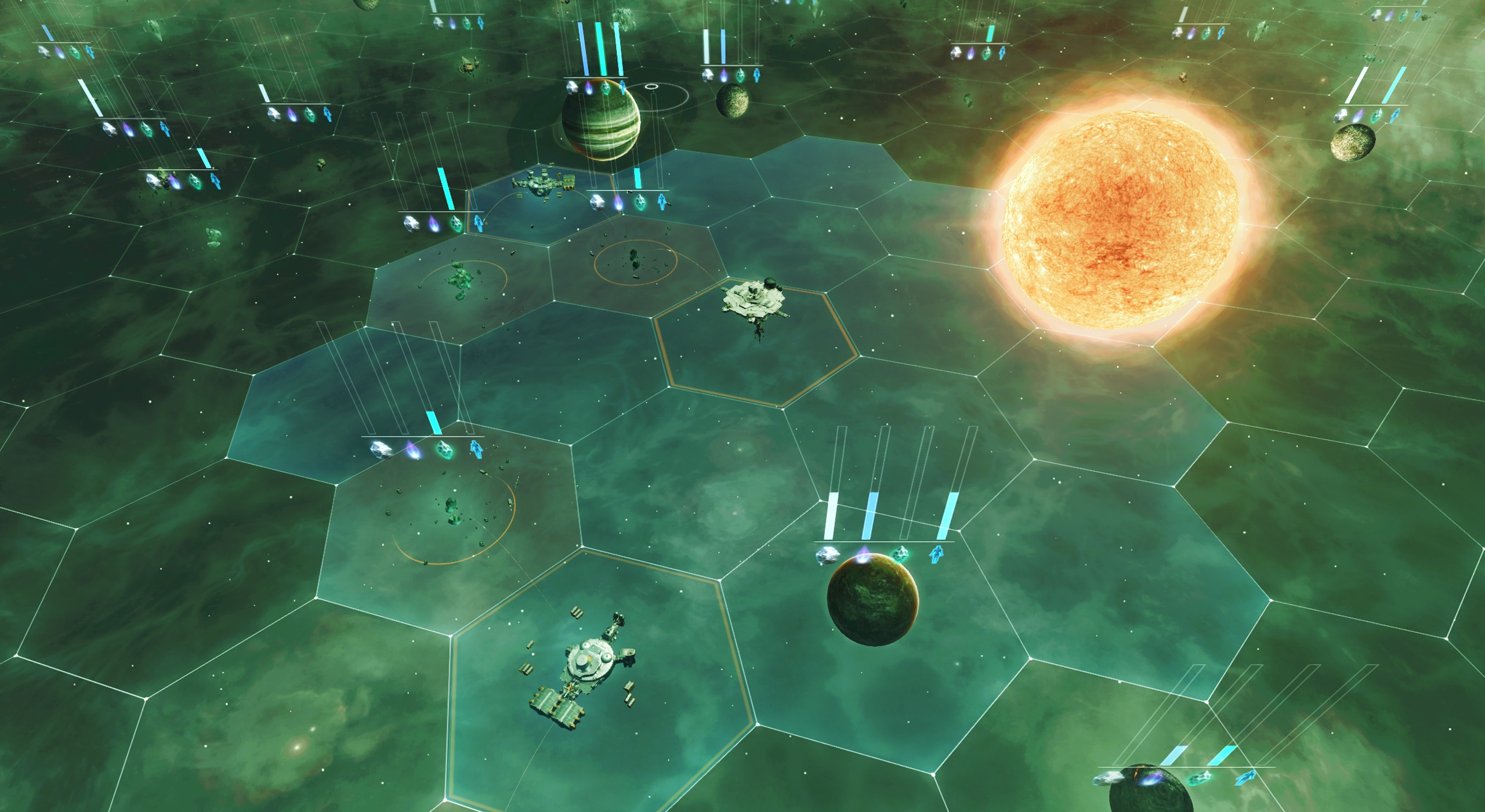Imagine playing an eight-week-long game of Civilization but set in space on a map with over 5,000 other players and you’ll start to get a picture of just how different Starborne is. Iceland has already developed a reputation for ambitious space games thanks to EVE Online, but the team at Solid Clouds, which includes several of EVE’s original developers, are intent on expanding that legacy by blending real-time strategy with EVE’s uncanny ability to create gripping space drama.
What grabbed me immediately about Starborne’s striking galaxy, parts of which have been in development as far back as 2014, is that it’s absolutely huge. Each server instance is made up of over 750,000 hexes and can currently support 5,130 different player empires. It’s all seamless and running in real time as you exploit planets and asteroids for resources, research tech, plop down new space stations, and churn out fleets to protect your holdings and assault your rivals. The goal of each session, which currently last roughly two months, is to take and maintain control of the most Dyson spheres (giant power plants that harness the energy of an entire star) at the center of each of the 19 sectors.
Doing so alone won’t be possible, so you’ll have to form alliances within your randomly assigned sector and, eventually, “alliances of alliances” called Confederations which can span multiple sectors to claim ultimate victory. The team at Solid Clouds assembled these ambitious ideas out of a general frustration with both traditional 4X games and browser-based MMORTSes. The former, they felt, were becoming more polished and streamlined but failing to push the envelope on scale, politics, and long-term, meaningful strategy. The latter, on the other hand, seemed to present shallow, hands-off experiences that weren’t as much about making overeating decisions as they were about waiting to accumulate enough stuff to win by brute force.
 Commanding your own space empire in a sprawling PvP-focused galaxy sounds daunting, but players aren’t expected to sit in the captain’s chair at all hours of the day. Starborne is “real-time strategy” in the sense that the clock keeps ticking whether you’re around or not, but there’s nothing twitch-based about it. In the early game when a lot is happening relatively quickly, technology or buildings might take 30 minutes of real time to finish. In the mid and late game, as things get more expensive and alliances start to coalesce, the team at Solid Clouds want you to be able to manage everything with maybe two or three short sessions a day. It’s the type of experience where you can be playing a round of Overwatch or Mordhau in another window and check in between matches to see if there’s anything that needs your attention.
Commanding your own space empire in a sprawling PvP-focused galaxy sounds daunting, but players aren’t expected to sit in the captain’s chair at all hours of the day. Starborne is “real-time strategy” in the sense that the clock keeps ticking whether you’re around or not, but there’s nothing twitch-based about it. In the early game when a lot is happening relatively quickly, technology or buildings might take 30 minutes of real time to finish. In the mid and late game, as things get more expensive and alliances start to coalesce, the team at Solid Clouds want you to be able to manage everything with maybe two or three short sessions a day. It’s the type of experience where you can be playing a round of Overwatch or Mordhau in another window and check in between matches to see if there’s anything that needs your attention.
Battles, which are resolved instantaneously when two fleets meet on the map, can take place without your direct commands. Your armada can be set to react to any potential attack on their own, and upgrades to your space stations like missile batteries will provide an additional layer of static defense. To get around the problem of coordinating large allied offensives when not everyone might be able to log on at the same time, offline players will be able to commit ships to a shared objective. When the player in charge of the operation hits go, their fleet will be joined by all of the allied ships that have been committed. This seems very powerful, and there currently isn’t an equivalent feature available for an alliance on the defensive, but Solid Clouds is looking into how they might be able to even that out.
You build up your Starborne empire using the core resources of metal, gas, crystal, and labor. Each randomized start will generally be rich in some but poor in others, which can steer your early strategy. Having a lot of crystal but not a lot of metal in your spawn area means you won’t be able to compete militaristically with a metal-rich player to begin, but you’ll be able to develop a strong industrial sector very quickly. This also creates incentives to cooperate with players who might have different resources available. The other major resource comes in the form of cards, which work kind of like gear you can equip to give either strong, temporary bonuses or smaller, permanent ones to specific aspects of your empire.
You can get cards through completing Tasks, which are short-term missions that become available periodically, and by crafting them with the earnable in-game currency, credits. Cards you don’t like or that become obsolete can be recycled for credits, as well. There will also be some way to acquire bonuses using real money, though the business model hasn’t been finalized yet and the devs are adamant on having a strict “hard cap” on how much of an advantage you can buy with real money in a given period of time.
 One of my biggest questions is whether Starborne will be able to create the same sort of Wild West atmosphere full of double-crosses, grand coalitions, and masterful plots we hear so much about in a game like EVE. The ingredients are certainly there, and bringing that ethos to a strategy game is definitely something I could lose myself in for a very long time. The fact that sessions have a finite length and everyone is going to start back at square one eventually might encourage more daring and cutthroat tactics. What do you have to lose, right? But it also decreases the stakes somewhat in comparison, since you’re not at risk of losing something that took actual years to acquire.
One of my biggest questions is whether Starborne will be able to create the same sort of Wild West atmosphere full of double-crosses, grand coalitions, and masterful plots we hear so much about in a game like EVE. The ingredients are certainly there, and bringing that ethos to a strategy game is definitely something I could lose myself in for a very long time. The fact that sessions have a finite length and everyone is going to start back at square one eventually might encourage more daring and cutthroat tactics. What do you have to lose, right? But it also decreases the stakes somewhat in comparison, since you’re not at risk of losing something that took actual years to acquire.
Starborne is already shaping up to be an MMORTS unlike anything I’ve played before, following the adventurous and boundary-pushing spirit I’d expect from its EVE developer DNA. Solid Clouds has a lot of ideas for how to expand it going forward, too, like adding sessions with different game speeds and rule sets, tournament servers, more dynamic galactic events, and ways to visually customize your empire. If you’d like to see where it’s at for yourself, you can register for the current alpha on the Starborne official site.
